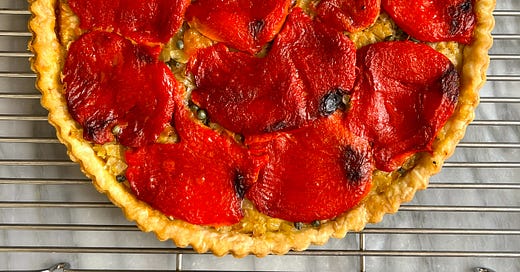AT THE END OF WINTER, if you’re impatient for all the literal and metaphorical warmth of summer, this tart could be just right. Bell peppers are available year-round, even if they’re not August sweet. The flavors of the tart are entirely Provençal; you might expect an olive oil crust, but for a long time a butter crust has been more common in published recipes from Provence. (Maybe oil is used more often in practice. I’ve been trying to make an oil crust that’s as flaky and tender as a butter crust, but I’m not there yet.) Olive oil is in the tart too, partly for flavor, which raises the question, What kind? Provence produces modern oil from green and violet fruit as well as the region’s original kind from fermented black olives, a rare example of oil that qualifies as virgin but not extra virgin. It contains no bitterness, no pepperiness, and it has a particular earthy flavor. It’s still pressed at some mills, including Moulin Cornille and Castelines, both in Les Baux. Look for words such as “vierge” and “fruité noir” or “black fruity.” To answer the question of which oil, either kind is excellent in its own way, but the black-fruity oil is more specific to the place. (If you’ve wondered why AoE recipes don’t call for “extra virgin” oil, that’s because the words describe the state of the oil when it was tested but say nothing about what happened to the oil afterward.) Oregano is the rare herb that’s much better dried than fresh, and imported Greek oregano is so much better than what I used to grow that I stopped growing it. Instead of capers in vinegar, you can use capers preserved in salt, which captures more of the flavor of the unopened buds, but the pique of vinegar from French-style ones is good and, for what it’s worth, I’ve never found evidence that in Provence capers were ever kept in salt.
© 2025 The Art of Eating
Substack is the home for great culture





